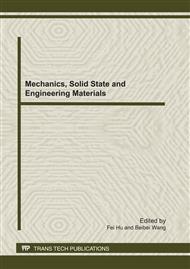p.3
p.10
p.16
p.22
p.28
p.33
p.39
p.44
Tribological Behaviors of Self-Lubricating Ceramic Tool Composite in Various Conditions
Abstract:
Al2O3/TiC ceramic composites with the addition of CaF2 solid lubrication were produced by hot pressing. The effects of various conditions on tribological behaviors of Al2O3/TiC/CaF2 have been studied. The sliding wear tests against cemented carbide and 45 steel were performed on the ceramic composites using ring-block method. Results showed that with the increase of load and sliding speed, the friction coefficient decreased. However, the wear rate increased slightly with the increase of load and decreased with the increase of sliding speed. At low speed, the abrasion resistance of Al2O3/TiC/CaF2 coupled with cemented carbide was better than with 45 steel, while the abrasion resistance showed little difference at high speed. The friction coefficients were little different when coupled with cemented carbide and 45 steel respectively. During the sliding process, at the initial stage, the friction coefficient was waved because the self-lubricating film was not formed on the worn surface; after sliding 628m, the friction coefficient was stable because the self-lubricating film was formed on the worn surface.
Info:
Periodical:
Pages:
22-27
Citation:
Online since:
July 2011
Authors:
Keywords:
Price:
Сopyright:
© 2011 Trans Tech Publications Ltd. All Rights Reserved
Share:
Citation:


